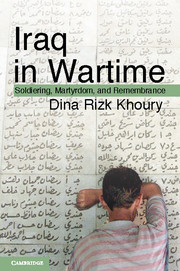Book contents
- Frontmatter
- Contents
- List of Illustrations, Maps, and Table
- Acknowledgments
- Note on Translations and Transliteration
- Maps
- 1 Introduction
- 2 Iraq’s Wars under the Ba‘th
- 3 The Internal Front
- 4 Battlefronts
- 5 Things Fall Apart
- 6 War’s Citizens, War’s Families
- 7 Memory for the Future
- 8 Commemorating the Dead
- 9 Postscript
- Appendix I Distribution in Percentage of Ba‘th Party Members, “Friends of Saddam,” and Martyrs in Fifteen Iraqi Provinces, 1998–1999
- Appendix II Percentage of Ba‘th Party Membership among Matriculating Students (Sixth Secondary) in Ten Iraqi Provinces, 1987–1988
- Appendix III Report Issued by Ali Hasan al-Majid, Head of the Northern Bureau of the Ba‘th Party to the General Secretariat, August 1987
- Sources and Bibliography
- Index
2 - Iraq’s Wars under the Ba‘th
Published online by Cambridge University Press: 05 March 2013
- Frontmatter
- Contents
- List of Illustrations, Maps, and Table
- Acknowledgments
- Note on Translations and Transliteration
- Maps
- 1 Introduction
- 2 Iraq’s Wars under the Ba‘th
- 3 The Internal Front
- 4 Battlefronts
- 5 Things Fall Apart
- 6 War’s Citizens, War’s Families
- 7 Memory for the Future
- 8 Commemorating the Dead
- 9 Postscript
- Appendix I Distribution in Percentage of Ba‘th Party Members, “Friends of Saddam,” and Martyrs in Fifteen Iraqi Provinces, 1998–1999
- Appendix II Percentage of Ba‘th Party Membership among Matriculating Students (Sixth Secondary) in Ten Iraqi Provinces, 1987–1988
- Appendix III Report Issued by Ali Hasan al-Majid, Head of the Northern Bureau of the Ba‘th Party to the General Secretariat, August 1987
- Sources and Bibliography
- Index
Summary
The history of the Iran-Iraq (1980–8) and First Gulf (1991) wars, as well as the twelve-year, UN-imposed sanctions regime (1991–2003), is best understood within three contexts: the ideology and the internal politics of the Ba‘thist state; the threat the Iranian Revolution posed to regional political order and Iraq’s place in it; and the emergence of a new global order led by the United States and increasingly administered by various international organizations such as the UN working closely with the United States to manage conflict and punish “criminal” regimes.
Iraq’s invasion of Iran in September 1980 was motivated by ideological factors as much as by political calculation. The Islamic revolution in Iran challenged the Ba‘thist secular ideology of revolutionary Arab nationalism and threatened Iraq’s ambitions for a regional leadership role. The anti-imperialist rhetoric of the Islamic revolution and the Iranian people’s ability to dislodge the Shah of Iran, a powerful U.S. ally, through peaceful means generated considerable excitement in the Arab world, the population of which had grown disillusioned with Arab nationalism. Unlike the Islamic Republic of Iran, the Ba‘thist regime had come to power through a military coup, not a popular mandate. In July 1968, Ahmad Hasan al-Bakr, a Ba‘thist army general, became president, and, less than a year later, appointed his kinsman Saddam Hussain vice chairman of the ruling Revolutionary Command Council, the highest legislative and executive body in Iraq.
- Type
- Chapter
- Information
- Iraq in WartimeSoldiering, Martyrdom, and Remembrance, pp. 20 - 47Publisher: Cambridge University PressPrint publication year: 2013

